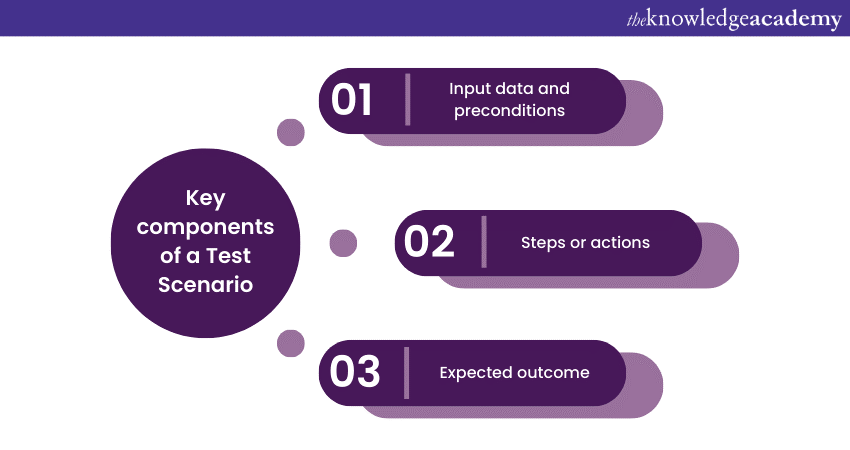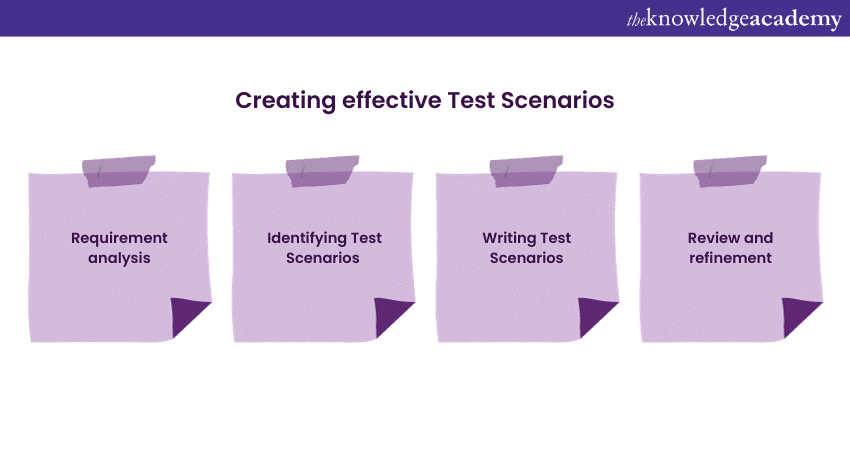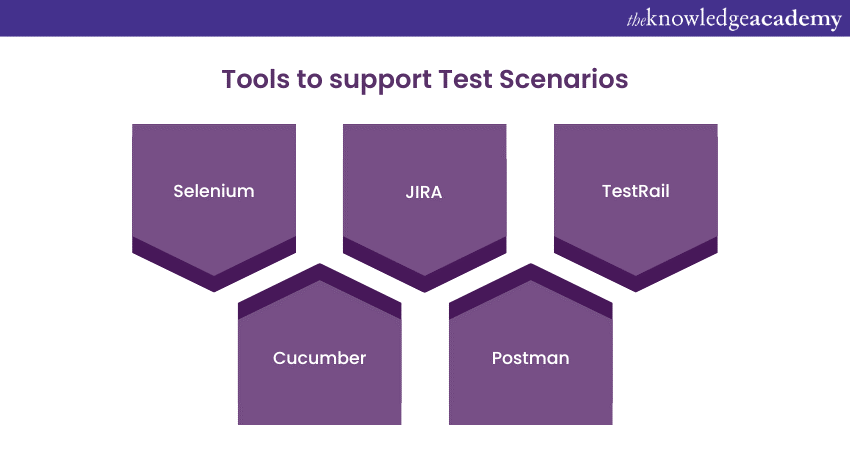We may not have the course you’re looking for. If you enquire or give us a call on +91 8037244591 and speak to our training experts, we may still be able to help with your training requirements.
Training Outcomes Within Your Budget!
We ensure quality, budget-alignment, and timely delivery by our expert instructors.

In Software Development, where functionality and User Experience reign supreme, Scenario Testing emerges as a beacon of assurance. Test Scenario in Software Testing, dives deep into the intricacies of user interactions, replicating real-world scenarios to validate software functionality.
This blog shall guide you through the intricacies surrounding Test Scenario in Software Testing, what it is, and how to create and Test a Scenario.
Table of Contents
1) Understanding Test Scenario in Software Testing
2) The significance of Test Scenarios
3) Key components of a Test Scenario
4) Creating effective Test Scenarios
5) Scenario Testing vs. Test Cases: What is the difference?
6) Tools to support Scenario Testing
7) Conclusion
Understanding Test Scenario in Software Testing
In Software Development, ensuring that a software product functions seamlessly across a multitude of Scenarios and user interactions is a monumental task. This is where the art and science of Software Testing come into play. Scenario Testing is one of the myriad Testing methodologies that shine brightly due to its effectiveness in emulating real-world User Experiences.
Scenario Testing is a methodological approach within software Testing that involves creating and executing a series of meticulously designed Test Scenarios. These Scenarios are crafted to replicate real-world situations, user behaviours, and interactions the software will likely encounter once deployed. By simulating these Scenarios, Software Testers can scrutinise how the software behaves, identify bugs, and ensure that it meets user expectations across various circumstances.
Ready to elevate your Software Testing skills? With our Software Testing Courses & Training, equip yourself with the tools to excel in Regression Testing and beyond.
The significance of Test Scenarios
Test Scenarios are pivotal in the Software Testing process, acting as bridges connecting Software Development and user expectations. The need to ensure that the developed application behaves as expected in real-world scenarios is at the heart of Software Testing. This real-world validation is precisely where Test Scenarios excel.
By meticulously designing systems that mimic user interactions, Testers can ensure that the software functions seamlessly under the exact conditions it will encounter in its intended environment.
By crafting methods covering various user journeys, features, and use cases, Testers can systematically traverse the entire application, uncovering bugs, glitches, and discrepancies that might otherwise remain hidden.
A software product's ultimate success hinges on meeting or exceeding user expectations. Test Scenarios provide a direct path to this alignment by validating whether the software performs as users anticipate. By crafting methods that mirror typical user behaviours, Testers ensure that the software functions correctly and resonates with the users' mental models, leading to enhanced user satisfaction.
Test Scenarios function as guardians of software quality by catching issues before they reach the hands of end-users. By simulating various interactions and usage patterns, methods can uncover potential bottlenecks, scalability concerns, or performance limitations. This pre-emptive identification of issues allows developers to address them proactively, resulting in a more stable and reliable software product.
Key components of a Test Scenario

Here’s a list of the key components that make up a Test Scenario:
a) At the heart of every Test Scenario lies input data and preconditions that set the stage for the Scenario's execution. This component outlines the initial state of the software, including factors such as user roles, system configurations, and existing data.
b) The sequence of steps or actions forms the core narrative of the Test Scenario. Like a user interacting with the software, each step represents a specific action taken within the application. These actions encompass a variety of functionalities, user interactions, and system responses. Articulating these steps meticulously not only guides the Tester's execution but also provides a comprehensive overview of the Scenario's flow and intricacies.
c) The expected outcome is the destination toward which the Scenario's journey leads. It defines the anticipated behaviour of the software after the sequence of steps is executed. This outcome is a benchmark against which the actual conduct is compared during Testing. It should be detailed, specific, and aligned with the software's requirements and user expectations.
A well-crafted Test Scenario seamlessly weaves these components together, creating a cohesive narrative that reflects real-world interactions while remaining focused on validating software functionality.
Creating effective Test Scenarios
Effective Scenario creation begins with a thorough analysis of the software's requirements. This entails delving deep into user stories, business specifications, and functional documentation to grasp the software's intended behaviour. The following points form the essence of creating effective Test Scenarios:

a) Requirement analysis not only shapes the Scenarios but also ensures that Testing efforts are aligned with the software's goals and objectives.
b) The identification phase involves brainstorming a range of user interactions, from routine tasks to edge cases and exceptional Scenarios.
c) Once the Test Scenarios have been identified, the Tester will then proceed towards writing the Test Scenarios.
d) Upon clearly defining the Test Scenarios, the Tester will then check them for anomalies. This will form the basis for reviews and further refinement if needed.
Take the next step in your career journey by enrolling in our Software Testing and Automation Training.
Scenario Testing vs. Test Cases: What is the difference?
Scenario Testing embodies a holistic approach to Testing, encompassing a series of interconnected interactions that mimic real-world User Experiences. Scenarios simulate user journeys through the software, combining multiple functions and paths.
They capture the intricacies of how users navigate and interact with the application, offering a bird's-eye view of end-to-end functionality. Scenarios focus on validating the software's flow, user-friendliness, and responsiveness in diverse situations. They often encompass many Test Cases under a single umbrella, reflecting a more high-level and user-centric perspective.
On the other hand, Test Cases are granular and specific instances within a Scenario or functionality. They address singular functions, actions, or conditions, meticulously detailing inputs, steps, and expected outcomes.
Test Cases dissect the software into manageable units, allowing Testers to validate each element individually. While Scenarios guide the overarching story, Test Cases delve into the nuances, uncovering defects or inconsistencies within isolated components.
Tools to support Test Scenarios
In the dynamic landscape of Software Testing, an array of sophisticated tools has emerged to streamline and enhance the practice of Scenario Testing.

1) Selenium: This open-source automation tool is renowned for its Web Application Testing capabilities. Selenium allows Testers to script and execute Scenarios across various browsers, ensuring consistent behaviour and User Experience.
2) JIRA: A versatile issue and project tracking tool, JIRA aids in organising and managing Test Scenarios. It facilitates team collaboration, enabling the creation, assigning, and tracking of Scenarios as user stories or tasks.
3) TestRail: TestRail provides a centralised platform for Test Case management and execution. It assists in organising Scenarios, tracking progress, and generating comprehensive reports that offer insights into Testing coverage and results.
4) Cucumber: This tool promotes collaboration between developers and non-technical stakeholders. It employs a plain-text syntax for defining Scenarios, making it easier for non-technical team members to understand while enabling automated execution.
5) Postman: Focusing on APIs, Postman simplifies Testing by allowing the creation and execution of Scenarios for API endpoints. It aids in validating API responses and interactions, which is critical for ensuring robust integrations.

Conclusion
In the evolving domain of Software Testing, Test Scenarios guide developers and Testers through the unknown waters of functionality validation. Software teams unravel defects by crafting Test Scenarios that mirror real-world interactions, ensure alignment with user expectations, and ultimately craft products that resonate with users, highlighting the need for Test Scenario in Software Testing.
Frequently Asked Questions
Upcoming Business Analysis Resources Batches & Dates
Date
 ISTQB Software Testing Foundation
ISTQB Software Testing Foundation
Mon 2nd Dec 2024
Mon 16th Dec 2024
Mon 6th Jan 2025
Mon 3rd Feb 2025
Mon 17th Feb 2025
Mon 3rd Mar 2025
Mon 17th Mar 2025
Mon 31st Mar 2025
Mon 28th Apr 2025
Mon 19th May 2025
Mon 2nd Jun 2025
Mon 16th Jun 2025
Mon 30th Jun 2025
Mon 14th Jul 2025
Mon 28th Jul 2025
Mon 11th Aug 2025
Mon 8th Sep 2025
Mon 22nd Sep 2025
Mon 6th Oct 2025
Mon 20th Oct 2025
Mon 3rd Nov 2025
Mon 17th Nov 2025
Mon 1st Dec 2025
Mon 15th Dec 2025







 Top Rated Course
Top Rated Course


 If you wish to make any changes to your course, please
If you wish to make any changes to your course, please


